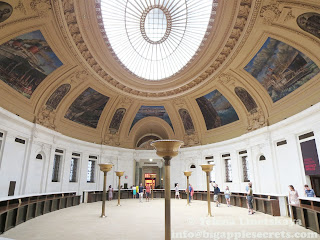 |
| Custom House at Bowling Green |
Constitution of the United States went into effect on March 4, 1789. A bit more than four months later, on July 31 of that year, the U.S. Customs Service started operating, among the very first of the federal agencies to come to life. On August 5, 1789 Captain James Weeks sailed his brigantine into New York harbor with a miscellaneous cargo from Italy. The duty on the cargo -- the first such payment ever made to the United States Treasury --was $774.41.
Before the imposition of the income tax in 1916, customs duties were the greatest single source of revenue for the U.S. government, and the Port of New York was the country's most prosperous trade center. From 1790 to 1799, New York Custom House was in downtown, at S. William Street, opposite Mill Lane.
From 1799 to 1815, Customs house moved to the Government House, that was built exactly on the same spot, where the first fort of New York, Fort Amsterdam was located and where in our days you can see an impressive structure of the Museum of American Indians.
 |
| 26 Wall Street |
The Government House was built in 1790 by the state for President George Washington but Washington never occupied it. Before the house was completed, in 1790, the federal government moved temporarily to Philadelphia, Pennsylvania; then permanently to Washington, D.C. In 1815 the land was sold to the public and the Government House building demolished. In 1842 Custom House moved to 26 Wall Street.
The house that everybody know now as Federal Hall, was the first house built specially for New York Customs. Twenty years later Customs Office, having outgrown the space, vacated the building and moved to 55 Wall Street, Merchant's Exchange Building.
 |
| 55 Wall street |
This job brought him national attention, but newyorkers primary know this architect because in 1913 he built Woolworth building, that had been the world’s tallest building for over a decade at that time.
 |
| Paris Opera Housed |
The seven story Customs House contains 450,000 square feet of space and sits on three city blocks. It was richly decorated inside and out, including dozens of sculptures and carved images. The inspiration for the Custom House was derived from the Paris Opera House, the most important Beaux-Arts building of the period. The Palais Garnier, a 1,979-seat opera house, was built in Paris from 1861 to 1875 by French architect Jean-Louis Charles Garnier.
 The Customs building incorporates Beaux Arts and City Beautiful movement planning principles, combining architecture, engineering, and fine arts.
The Customs building incorporates Beaux Arts and City Beautiful movement planning principles, combining architecture, engineering, and fine arts. Sculpture was so important for the architect that there were independent contracts for four sculpture groups in front of the building and standing sculptures above the main cornice.
"Continents", four female figures of limestone done by the sculptor Daniel Chester French, sit on large entrance pedestals and represent America, Asia, Europe, and Africa. Daniel French is one of the most productive and acclaimed American sculptors of the late nineteenth and early twentieth centuries. He is best known for his design of the statue of Abraham Lincoln in the Lincoln Memorial, Washington, D.C
When viewed from left to right, the first sculpture of the set is "Asia".
 |
| Asia |
 |
| Africa |
Native American wearing a warrior's headdress is behind here right shoulder.
"Europe" sits on a throne decorated with a frieze from the Parthenon in Athens with her right hand resting on the bow of a ship with a lion's head, symbolizing the conquests of Europe. "Africa" is nude and sleeping.
 |
| Europe |
Nude- because for most people of that time there were only naked tribes there and the "sleeping continent" was a common way of referring to Africa.
Statues representing 12 seafaring nations stand above the front facade’s columns; the Corinthian capitals of the columns include the head of Mercury (representing commerce); second-story windows are topped by heads representing the “eight races of mankind.” Among the 12 top Nations there is Belgium. The statue was originally "German" , but was changed after the outbreak of World War I.
 |
| America |
 |
| Great Rotonda |
 |
| Ambrose (Mural on the wall) |
The building was empty for a decade, and slated for demolition until Senator Daniel Patrick Moynihan sponsored a bill to restore the Custom House.
Now, the building is shared by the U.S. Bankruptcy Court, the National Archives, and the National Museum of the American Indian (Smithsonian Institution). You can read about the Museum in my next post.


thank you most enlightening
ReplyDelete